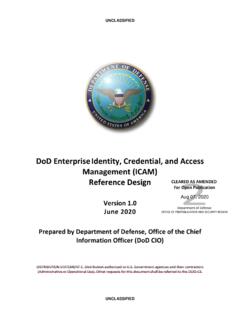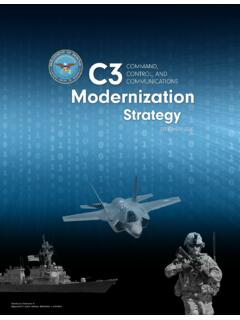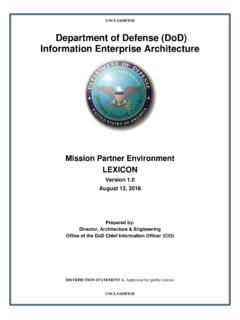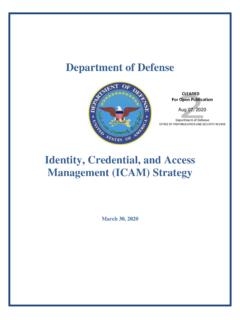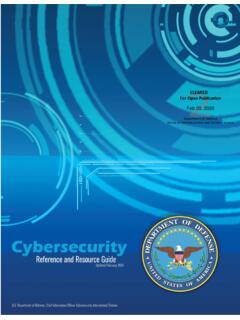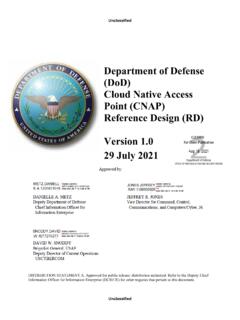Transcription of Home DoDAF-DM2 WG DoDAF Journal DoD Meta Data …
1 DoDAF Architecture Framework Version [3/3/2011 3:33:35 PM] HomeDoDAF-DM2 WGDoDAF JournalDoD Meta data RegistryIDEASL inksThe DoDAF Architecture Framework Version to DoDAF Version ! This is the official and current version for the Departmentof Defense Architecture is the current release of DoDAF as of PDF version of this website is producedperiodically and can be downloaded here: a description of changes made to to create DoDAF /DM2 , download the Version Description Document ConformanceDoD Components are expected to conform to DoDAF to the maximum extent possiblein development of architectures within the Department. Conformance ensures thatreuse of information, architecture artifacts, models, and viewpoints can be shared withcommon understanding. Conformance is expected in both the classified andunclassified communities, and further guidance will be forthcoming on specificprocesses and procedures for the classified architecture development efforts in conformance is achieved when:The data in a described architecture is defined according to the DM2 concepts,associations, and architectural data is capable of transfer in accordance with the JournalThe DoDAF Journal is a community of interest based discussion board.
2 The Journal includesdescriptions of best practices, lessons learned, example views and DM2 datasets, DoDAFmodel templates, DoDAF meeting presentations, and tutorial materials, and referencedocuments. It can be used by reference, component, capability, segment, and solutionarchitects and core process stakeholders. Any member of the DoDAF community may submitmaterial for publication and an editorial board will work with the authors to determineappropriateness, ensure public releasability, and make any needed changes to content. Contact InformationFor any general enquiries, please contact us via the general enquiry mailboxes listed on ourcontact page. BackgroundArchitecture DevelopmentMeta ModelViewpoints & ModelsPresentation TechniquesConfiguration ManagementOverviewAcronyms List and Glossaryof TermsSite MapArchives Department of Defense1 DoDAF Architecture Framework Version [3/3/2011 3:33:35 PM]Go to top of page Privacy Policy | Web Policy | Contacts2 DoDAF [3/3/2011 3:33.]
3 50 PM] HomeDoDAF-DM2 WGDoDAF JournalDoD Meta data RegistryIDEASL inksIntroductionThe Department of Defense Architecture Framework ( DoDAF ), Version is theoverarching, comprehensive framework and conceptual model enabling the development ofarchitectures to facilitate the ability of Department of Defense (DoD) managers at all levelsto make key decisions more effectively through organized information sharing across theDepartment, Joint Capability Areas (JCAs), Mission, Component, and Program DoDAF serves as one of the principal pillars supporting the DoD Chief InformationOfficer (CIO) in his responsibilities for development and maintenance of architecturesrequired under the Clinger-Cohen Act. DoDAF is prescribed for the use and development ofArchitectural Descriptions in the Department. It also provides extensive guidance on thedevelopment of architectures supporting the adoption and execution of Net-centric serviceswithin the managers, as process owners, specify the requirements and control the development ofarchitectures within their areas of authority and responsibility.
4 They select an architect andan architecture development team to create the architecture in accordance with therequirements they Components are expected to conform to the DoDAF developing architectures within theDepartment. DoDAF Conformance ensures reuse of information and that architectureartifacts, models, and viewpoints can be shared with common focuses on architectural " data ", rather than on developing individual "products"as described in previous versions. In general, data can be collected, organized, and storedby a wide range of architecture tools developed by commercial sources. It is anticipated thatthese tools will adopt the DM2 PES for the exchange of architectural provides a data Capture Method for each data group of the DM2 to guidearchitects in collecting and organizing the necessary architectural DoDAF enables architectural content that is "Fit-for-Purpose" as an architecturaldescription consistent with specific project or mission objectives.
5 Because the techniques ofarchitectural description can be applied at myriad levels of an enterprise, the purpose or useof an architectural description at each level will be different in content, structure, and level ofdetail. Tailoring the architectural description development to address specific, well-articulated, and understood purposes, will help ensure the necessary data is collected at theappropriate level of detail to support specific decisions or architectural data is accomplished through models ( , the products describedin previous versions of DoDAF ). Models can be documents, spreadsheets, dashboards, orother graphical representations and serve as a template for organizing and displaying data ina more easily understood format. When data is collected and presented as a "filled-in"model, the result is called a view. Organized collections of views (often representingprocesses, systems, services, standards, etc.) are referred to as viewpoints, and withappropriate definitions are collectively called the Architectural discusses DoDAF -described Models and Fit-for-Purpose Views: DoDAF -described Models (also referred to as Models) are created from thesubset of data for a particular purpose.
6 Once the DoDAF -described Models arepopulated with data , these "views" are useful as examples for presentation purposes,and can be used as described, modified, or tailored as core Processes DoDAFS upportsDM2 Support for the Six CoreProcesses DoDAF SupportsWhat is New in DoDAF DevelopmentMeta ModelViewpoints & ModelsPresentation TechniquesConfiguration ManagementOverviewAcronyms List and Glossaryof TermsSite MapArchives Department of Defense3 DoDAF [3/3/2011 3:33:50 PM]Fit-for-Purpose Views are user-defined views of a subset of architectural datacreated for some specific purpose ( , "Fit-for-Purpose"). While these views are notdescribed or defined in DoDAF , they can be created, as needed, to ensure thatpresentation of architectural data is easily understood. This enables organizations touse their own established presentation preferences in their models described in DoDAF , including those that are legacies from previous versions ofthe Framework, are provided as pre-defined examples that can be used when developingpresentations of architectural DoDAF -described Models for a particular purpose are prescribed by the DoDAF -described Models do not have to be created.
7 If an activity model is created, anecessary set of data for the activity model is required. Key process owners will decide whatarchitectural data is required, generally through DoDAF -described Models or Fit-for-PurposeViews. However, other regulations and instructions from the DoD and the Chairman, JointChiefs of Staff (CJCS) have particular presentation view architect and stakeholders select views to ensure that the Architectural Descriptions willsupport current and future states of the process or activity under review. SelectingArchitecture Viewpoints carefully ensures that the views adequately frame concerns, , byexplaining the requirements and proposed solutions, in ways that enhance also serves as the principal guide for development of integrated architectures asdefined in DoD Instruction , which defines an integrated architecture as "Anarchitecture consisting of multiples views or perspectives facilitating integration andpromoting interoperability across capabilities and among integrated architectures".
8 The termintegrated means that data required in more than one instance in architectural views iscommonly understood across those DM2 provides information needed to collect, organize, and store data in a way DM2 replaces the core Architecture data Model (CADM) which supported previousversions of the DoDAF . DM2 is a data construct that facilitates reader understanding of theuse of data within an architecture document. CADM can continue to be used in support ofarchitectures created in previous versions of DoDAF . NOTE: DoDAF does NOTprescribe a Physical data Model (PDM), leaving that task to software developerswho will implement the principles and practices of DoDAF in their own is a marked change from earlier versions of Command, Control,Communications, Computers, and Intelligence Surveillance Reconnaissance ArchitectureFramework (C4 ISR AF) or DoDAF , in that architects now have the freedom to createenterprise architectures to meet the demands of their customers.
9 The core of DoDAF isa data -centric approach where the creation of architectures to support decision-making issecondary to the collection, storage, and maintenance of data needed to make efficient andeffective decisions. The architect and stakeholders select views to ensure that architectureswill explain current and future states of the process or activity under review. Selectingarchitectural views carefully ensures that they adequately explain the requirement andproposed solution in ways that will enhance audience also provides, but does not require, a particular methodology in architecturedevelopment. It provides guidance and suggestions on how to ensure that other proposedmethods can be adapted as needed to meet the DoD requirements for data collection andstorage. Similarly, the views presented in DoDAF are examples, intended to serve as apossible visualization of a particular view. DoDAF also continues providing support forviews ( , 'products' developed in previous versions of the Framework).
10 These views do notrequire any particular graphical design by toolset : Law and Policy DoDAF SupportsFederal law and policies have expressed the need for architectures in support of business4 DoDAF [3/3/2011 3:33:50 PM] Actof 1996 Recognizes the need for Federal Agencies to improve the way theyselect and manage IT resources and states, information technologyarchitecture, with respect to an executive agency, means an integratedframework for evolving or maintaining IT and acquiring new IT toachieve the agency s strategic goals and information resourcesmanagement goals. Chief Information Officers are assigned theresponsibility for developing, maintaining, and facilitating theimplementation of a sound and integrated IT architecture for theexecutive agency .E-GovernmentAct of 2002 Calls for the development of Enterprise Architecture to aid in enhancingthe management and promotion of electronic government services ofManagement andBudget CircularA-130 Establishes policy for the management of Federal informationresources and calls for the use of Enterprise Architectures to supportcapital planning and investment control processes.
